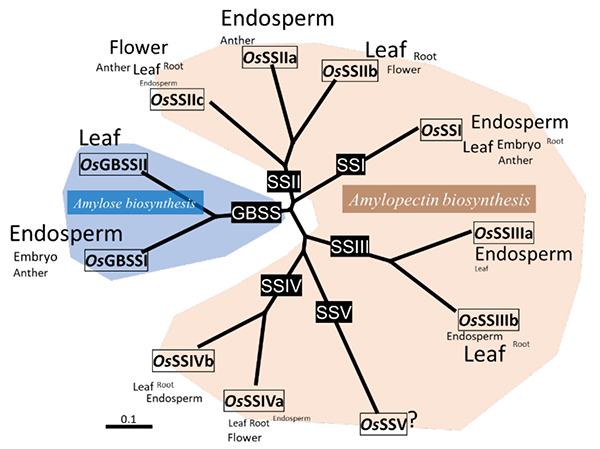 |
Starch synthase (SS), a key enzyme (glycosyl transferase) in starch biosynthesis, elongates the non-reducing end of the α-1,4 glucan chains of starch using ADP-glucose as a donor substrate. There are several SS isozymes in green plants, which are largely divided into two families: soluble starch synthases (SS), involved in amylopectin synthesis, and granule-bound starch synthases (GBSS), involved in amylose synthesis. SS cannot perform so-called de novo synthesis (i.e., synthesize maltose from a single glucose residue) and requires a primer longer than maltose for chain elongation.
The SS subfamilies involved in amylopectin biosynthesis are SSI, SSII, SSIII, and SSIV, with subfamilies other than SSI often having multiple additional isozymes and different organs of expression (Fig.). While SS genes are encoded in the nucleus, they function in amyloplasts of storage organs and in chloroplasts of green leaves. They possess a transit peptide at their N-terminal side that allows them to pass through the plastid bilayer. Each SS isozyme has a well conserved region containing the active site on its C-terminal side and N-terminal extensions that vary widely between SS isozymes.
The function of each SS isozyme has been clarified by the analysis of defective mutants and recombinants in various plant species and by in vitro analysis of purified enzymes. Although the contribution of each isozyme differs depending on the plant species, SSI, SSII, SSIII, and GBSSI share common functions in different plant species. Deficiency of a particular isozyme may indirectly affect the expression levels of other isozymes, which has a significant impact on starch structure and properties.
GBSS is an enzyme that synthesizes amylose and is widely present in green plants. GBSSI-deficient mutants were the earliest known as glutinous mutants, which have no or greatly reduced amylose content. Glutinous starches from maize and rice are widely used in food processing applications because they exhibit properties completely different from those of non-glutinous starch, which contains amylose.
SSI-deficient mutants have been isolated for Arabidopsis and rice (1). Although SSI accounts for the majority of SS activity of the soluble fraction in developing rice endosperm, the seed weight of the rice SSI mutant is not different from that of the wild type. This indicates that other SS isozymes compensate for the defect in chain length elongation in this mutant. However, chain length distribution analysis of amylopectin has revealed higher amounts of amylopectin with degrees of polymerization (DP) of 6-7 and 16-19 glucose units and lower amounts with DP of 8-12 glucose units in this mutant than in the wild type, indicating that SSI elongates from short amylopectin chains with DP6-7 to DP8-12 (1).
SSII-deficient mutants have been isolated for pea, Arabidopsis, potato, wheat, and rice, all of which generally possess a higher amount of amylopectin with short chains (DP≤12) and a lower amount with medium chains (DP13-24). This greatly reduces the starch gelatinizing temperature and has a significant impact on cooking. In rice, most indica rice cultivars have high SSIIa activity (wild type) whereas most japonica rice cultivars have low SSIIa activity. As a result, the gelatinizing temperature of japonica rice is about 10°C lower than that of indica rice (2).
SSIII-deficient mutants have been isolated for maize, potato, rice and Chlamydomonas. The direct effect of SSIII deficiency is a reduction in the number of long chains (DP≥33) connecting clusters of amylopectin. In addition to this, an indirect effect is higher amylose content due to increased expression of GBSSI (3).
The chloroplasts of the SSIV-deficient mutant of Arabidopsis exhibit one enlarged starch granule instead of the large number normally observed in wild-type chloroplasts, suggesting that SSIV is involved in the initiation of the synthesis of starch granules (4). However, this phenomenon does not appear to be universal in green plants. The starch properties of the endosperm in the SSIVb rice mutant are not appreciably different from those of the endosperm in the wild type. The function of SSIVb is thought to be redundant with SSIIIa besed on the researches of ss3a ss4b double mutant (5). This difference of the SSIV function between Arabidopsis and rice may be because Arabidopsis has only one SSIV isozyme, whereas rice has two, and because the two plants have different organs that mainly accumulate starch.
 |
Fig.
Phylogenetic tree of rice starch synthase (SS) isozymes, with GBSS involved in amylose synthesis and other SS involved in amylopectin synthesis. The letter size of each organ indicates the strength of expression with reference to RiceXPro (https://ricexpro.dna.affrc.go.jp/).
|
Naoko Fujita
(Department of Biological Production, Akita Prefectural University)
| References |
| (1) |
Fujita N, Yoshida M, Asakura N, Ohdan T, Miyao A, Hirochika H, Nakamura Y: Function and characterization of starch synthase I using mutants in rice. Plant Physiol. 140, 1070-1084, 2006 |
| (2) |
Nakamura Y, Francisco PB Jr, Hosaka Y, Sato A, Sawada T, Kubo A, Fujita N: Essential amino acids of starch synthase IIa differentiate amylopectin structure and starch quality between japonica and indica rice varieties. Plant Mol. Biol. 58, 213-227, 2005 |
| (3) |
Fujita N, Yoshida M, Kondo T, Saito K, Utsumi Y, Tokunaga T, Nishi A, Satoh H, Park JH, Jane JL, Miyao A, Hirochika H, Nakamura Y: Characterization of SSIIIa-deficient mutants of rice: the function of SSIIIa and pleiotropic effects by SSIIIa deficiency in the rice endosperm. Plant Physiol. 144, 2009-2023, 2007 |
| (4) |
Roldán I, Wattebled F, Mercedes Lucas M, Delvallé D, Planchot V, Jiménez S, Pérez R, Ball S, D'Hulst C, Mérida A: The phenotype of soluble starch synthase IV defective mutants of Arabidopsis thaliana suggests a novel function of elongation enzymes in the control of starch granule formation. Plant J. 49, 492-504, 2007 |
| (5) |
Toyosawa Y, Kawagoe Y, Matsushima R, Crofts N, Ogawa M, Fukuda M, Kumamaru T, Okazaki Y, Kusano M, Saito K, Toyooka K, Sato M, Ai Y, Jane JL, Nakamura Y, Fujita N: Deficiency of Starch Synthase IIIa and IVb Alters Starch Granule Morphology from Polyhedral to Spherical in Rice Endosperm. Plant Physiol. 170, 1255-1270, 2016 |
Jun. 15, 2023
|
|---|







